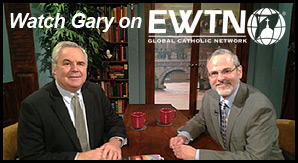“If we wish to discover in all its richness the profound relationship between the Church and the Eucharist, we cannot neglect Mary, Mother and model of the Church…Mary can guide us toward this most holy sacrament because she herself has a profound relationship with it.” (Blessed Pope John Paul II, Ecclesia de Eucharistia)
At the center of our Catholic Faith is the belief in the Real Presence of Jesus in the Eucharist. Unfortunately, we often lose sight of or don’t appreciate the profound blessing that we have been granted. If we desire to become better Catholics and improve our relationship with the Lord, we must deepen our love for the Eucharist. How can we do so? One of the best and most underutilized ways is to turn to the Mother of Jesus, Mary. By getting to know her and studying her life, we can grow closer to Our Lord who is fully present in the Eucharist. In his encyclical, Ecclesia de Eucharistia, Blessed Pope John Paul II devotes an entire chapter to Mary, “Woman of the Eucharist”. Let’s examine some of his thoughts on how Our Lady can help us better understand the Real Presence of Jesus in the Eucharist.
Our Lady of the Most Blessed Sacrament
Sometimes referred to as Our Lady of the Most Blessed Sacrament, Mary can take us by the hand and lead us to a closer relationship with the Eucharistic Christ. While observing that “at first glance”, the Gospel is silent on the subject of Mary and the Eucharist, the late Holy Father makes an interesting observation. We know that Mary was present with the apostles who prayed “with one accord” (Acts 1:14) for the coming of the Holy Spirit. Therefore, it follows that Mary was most certainly present at the Eucharistic celebrations of the early Christians who were devoted to “the breaking of bread” (Acts 2:42). Blessed John Paul II then points to Mary’s interior disposition and observes that Mary is a “woman of the Eucharist” in her whole life.
A Mystery of Faith
Scripture tells us that faith is “the assurance of things hoped for, the conviction of things not seen” (Hebrews 11:1). The Eucharist is certainly a mystery of faith and cannot be grasped by our limited human understanding. Accepting Jesus’ command to “Do this in memory of me”, requires us to deny our senses and humbly submit to His instruction. What better advice can we be given than the words of Mary at the wedding feast of Cana when she stated, “Do whatever He tells you” (John 2:5)? Just as He changed water into wine, He can turn ordinary bread and wine into His Body and Blood. By listening to Mary’s advice, we can accept (without fully understanding) the miracle that occurs on the altar and embrace Our Lord’s words, “He who eats my flesh and drinks my blood has eternal life” (John 6:54).
The Fiat and the Amen
By offering her womb for the Incarnation of God’s Word, Mary lived her Eucharistic faith even before the institution of the Eucharist. At the Annunciation, when Mary conceived the Son of God, she foreshadowed what happens to us when we receive Holy Communion. As a result, according to Blessed John Paul II, “there is a profound analogy between the Fiat which Mary said in reply to the angel, and the Amen which every believer says when receiving the Body of the Lord”. Although we sometimes forget the significance of our response to the words “The Body of Christ”, by replying “Amen” we are expressing our belief that Jesus is truly present in the Eucharist. Mary’s belief in the mystery of the Annunciation (“Blessed is she who believed”) anticipates the Church’s belief in the Eucharist.
Sacrifice
It is impossible to deny that there is a sacrificial dimension to the Eucharist. The Body and Blood of He whom we receive in this great sacrament was sacrificed for our redemption. Just as suffering was a major part of Our Lord’s life, it was a constant theme in the life of Mary. Beginning with Simeon’s crucifixion prophecy at the Lord’s Presentation (“a sword will pierce your soul”) and culminating with Our Lord’s death on the Cross, Mary had a very real share in the suffering of Christ. In this encyclical, the Holy Father made the following profound observation:
In her daily preparation for Calvary, Mary experienced a kind of ?anticipated Eucharist? ? one might say a ?spiritual communion? ? of desire and of oblation, which would culminate in her union with her Son in his passion, and then find expression after Easter by her partaking in the Eucharist which the Apostles celebrated as the memorial of that passion.
The Magnificat
According to Blessed Pope John Paul II, “in the Eucharist the Church is completely united to Christ and His sacrifice and makes her own the spirit of Mary. This truth can be understood more deeply by re-reading the Magnificat in a Eucharistic key”. He points out that when Mary proclaims “My soul magnifies the Lord and my spirit rejoices in God my Savior”, she is praising God “through” Jesus (who is in her womb), “in” Jesus and “with” Jesus. This, he observes, is the true “Eucharistic attitude” and that “the Eucharist has been given to us so that our life, like that of Mary, may become completely a Magnificat”. Saint Louis de Montfort, who greatly inspired John Paul II, recommended that the Magnificat be recited after the reception of Holy Communion. In doing so, we unite our voice with that of Mary and allow our often weak faith to be infused by her perfect and unfailing faith!
My soul proclaims the greatness of the Lord,
my spirit rejoices in God my Savior
for he has looked with favor on his lowly servant.
From this day all generations will call me blessed:
the Almighty has done great things for me,
and holy is his Name.
He has mercy on those who fear him
in every generation.
He has shown the strength of his arm,
he has scattered the proud in their conceit.
He has cast down the mighty from their thrones,
and has lifted up the lowly.
He has filled the hungry with good things,
and the rich he has sent away empty.
He has come to the help of his servant Israel
for he remembered his promise of mercy,
the promise he made to our fathers,
to Abraham and his children forever.
During this month devoted to Mary, why not take some time and meditate on her role as Our Lady of the Most Blessed Sacrament? There is no better person to help us increase our appreciation for the Eucharist than the Mother of Our Lord. She knows Him better than any other human. Ask her to help you believe the “unbelievable”!
“Mary is present, with the Church and as the Mother of the Church, at each of our celebrations of the Eucharist. If the Church and the Eucharist are inseparably united, the same ought to be said of Mary and the Eucharist.” (Blessed Pope John Paul II, Ecclesia de Eucharistia)









This is absolutely beautiful Gary – plenty of meat to chew on here for a long time!
Thank you, Shane. Coming from an excellent writer such as yourself, that means A LOT!
If Mary is “Woman of the Eucharist” and “Our Lady of the Most Blessed Sacrament” and was one of the first woman present at the Eucharistic celebrations of the early Christians who were devoted to ?the breaking of bread? AND By offering her womb for the Incarnation of God?s Word, Mary lived her Eucharistic faith even BEFORE the institution of the Eucharist (which sounds like she IS the Eucharist or the first to partake in the Eucharist.) And the pope says “In her daily preparation for Calvary, Mary experienced a kind of ?anticipated Eucharist? ? one might say a ?spiritual communion?….why do we not let all mothers have the chance to consecrate the bread to the body of the Lord? Why is it only the men (priest) get to do it, who experienced the Eucharist after Mary did, for Mary was the first to experience the greatness of the Lord’s Glory?